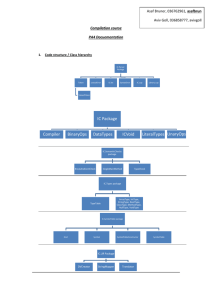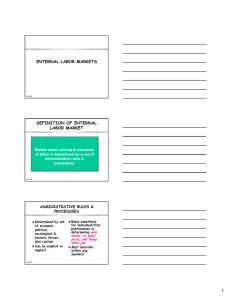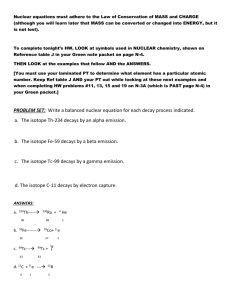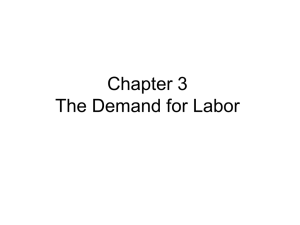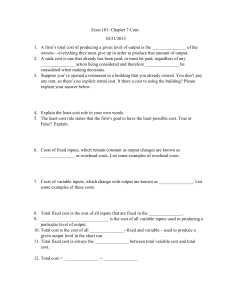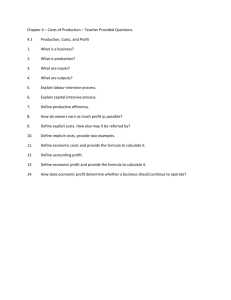DEMAND FOR LABOR OVERVIEW: ¾ Question of interest:
advertisement
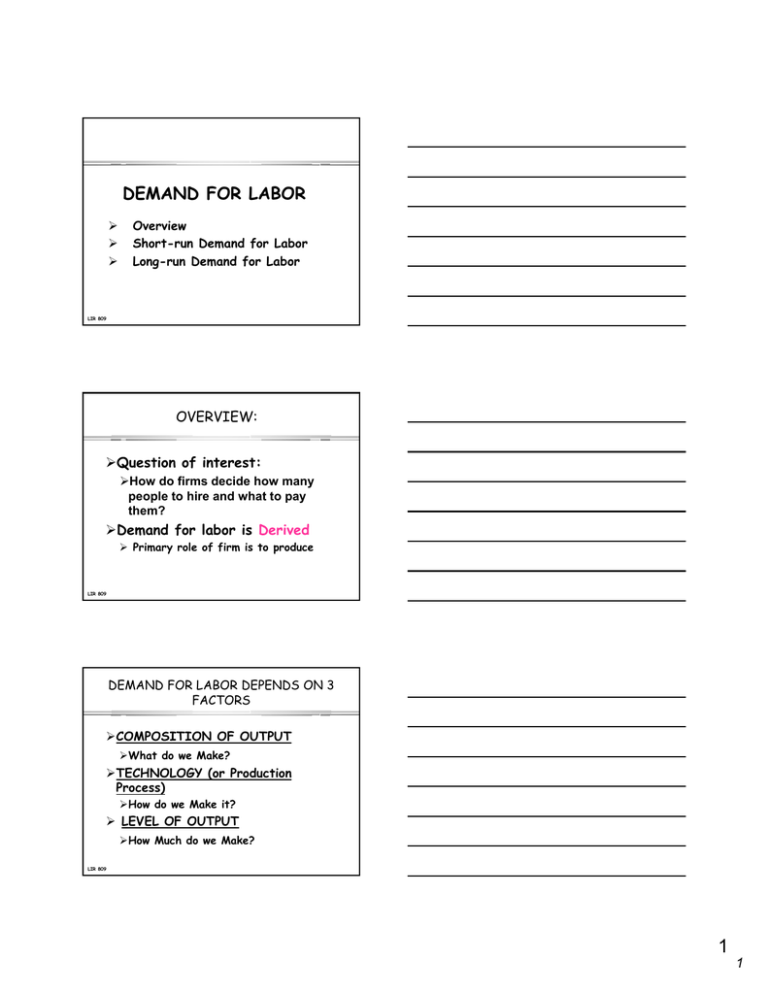
DEMAND FOR LABOR ¾ ¾ ¾ Overview Short-run Demand for Labor Long-run Demand for Labor LIR 809 OVERVIEW: ¾Question of interest: ¾How do firms decide how many people to hire and what to pay them? ¾Demand for labor is Derived ¾ Primary role of firm is to produce LIR 809 DEMAND FOR LABOR DEPENDS ON 3 FACTORS ¾COMPOSITION OF OUTPUT ¾What do we Make? ¾TECHNOLOGY (or Production Process) ¾How do we Make it? ¾ LEVEL OF OUTPUT ¾How Much do we Make? LIR 809 1 1 Firms Have to take 3 Markets into Account LIR 809 PRODUCTION FUNCTION (Formal version of how, what, how much) Q = F(x1,x2,...L,K) or Q = G(x1,x2,...L1,.L2, K1,.K2) Where: Q is quantity of output • x1,x2 are intermediate inputs or raw materials • L is labor • K is capital LIR 809 EXAMPLE: PRODUCING A SUMMER DINNER PARTY ¾ BASE CASE: SALAD FOR 4 ¾ Intermediate inputs: ¾ 1 head of lettuce, 2 tomatoes, 1 onion, stuff for 1/2 cu. mayonnaise ¾ Capital: ¾ Cutting Board, knife, bowl, wire whisk ¾ Labor: ¾ 1 Person hour ¾ NEW LEVEL OF OUTPUT: SALAD FOR 24 ¾ Intermediate inputs: ¾ 6 heads of lettuce, 12 tomatoes, 2 onions, stuff for 1 1/2 cu. mayonnaise ¾ Capital: ¾ Cutting Board, knife, bowl, wire whisk ¾ Labor: ¾ 4 person hours LIR 809 2 2 EXAMPLE, CONT. ¾ CHANGE IN TECHNOLOGY: SALAD FOR 24 ¾ Intermediate inputs: ¾ 6 heads of lettuce, 12 tomatoes, 2 onions, stuff to make 1 1/2 cu. mayonnaise ¾ Capital: 1 Cuisinart ¾ Labor: 1 person hour ¾ CHANGE IN COMPOSITION OF OUTPUT: PIG ROAST FOR 24 ¾ Intermediate inputs: ¾ 1 pig, firewood, 1 apple ¾ Capital: Shovel, spit ¾ Labor: 6 person hours LIR 809 ASSUMPTIONS OF SIMPLE MODEL OF LABOR DEMAND 1. Employers want to maximize Profits 2. Two factors of production: Capital & Labor: Q = f(L,K) 3. Labor is homogeneous 4. Hourly wage only cost of labor 5. Both labor market and product market are competitive. LIR 809 II. SHORT-RUN DEMAND FOR LABOR ¾Major Distinction between long and short run. In short run: ¾Firm can only vary labor to change output ¾Technology is fixed ¾ Product price does not change LIR 809 3 3 THE FIRM’S PROBLEM: HOW MANY WORKERS TO HIRE? ¾Firm’s Problem: Needs labor to produce output & needs decision rule to determine how much labor to use ¾Answer based on Marginal Productivity Theory of Labor: ¾Answer: Hire additional workers as long as each one adds to firm’s profits LIR 809 SOME DEFINITIONS ¾ MARGINAL PRODUCT OF LABOR (MPL) ¾ Additional output produced with one additional unit of labor ¾ MARGINAL REVENUE (MR) ¾ Additional revenue generated by selling one additional unit (= product price in competitive economy) ¾ MARGINAL REVENUE PRODUCT OF LABOR (MRPL) ¾ Extra revenue generated by selling one additional unit that can be attributed to labor ¾ MRPL = (MPL) * MR ¾ MARGINAL COST OF LABOR LIR 809 ¾ Cost of hiring 1 additional unit of labor (=wage in competitive economy) DEMAND FOR LABOR: FIRMS LOOKING FOR A ‘STOPPING RULE’ ¾ MARGINAL PRODUCT CURVE ¾ Visual representation of the effect on output of adding 1 more worker ¾ MPL is positive as long as output increases with additional labor ¾ WHY OUTPUT BEGINS TO DECLINE: LAW OF DIMINISHING RETURNS ¾ Increases in output begin to decline with increases in 1 input with other inputs constant LIR 809 4 4 DECISION RULE FOR EMPLOYMENT LEVEL ¾Recall: Firms maximize profits ¾Firms hired up to point where MRP from hiring last worker = marginal cost of that worker If MRPL > MCL, increase employment If MRPL < MCL, decrease employment If MRPL = MCL, do not change employment LIR 809 Marginal Product Curve Marginal Product Labor LIR 809 Relationship between Marginal and Total Product Marginal Product Total Labor LIR 809 5 5 DETERMINING HOW MANY TO HIRE Labor 0 1 2 3 4 5 6 Qty. 0 6 14 20 24 27 29 MP 0 6 8 6 4 3 2 MR 0 2 2 2 2 2 2 MRP 0 12 16 12 8 6 4 MC 0 6 6 6 6 6 6 LIR 809 Demand Curve Demand curve starts here Marginal Product Labor LIR 809 Demand Curve Demand curve starts here Marginal Product Market wage rate Stop hiring here Labor LIR 809 6 6 WHAT THIS SAYS ABOUT WAGES ¾ EFFICIENT POINT: ¾ MCL = MRPL or ¾ MCL = MR * MPL ¾ In competitive economy, MCL = W and MR = P, so: ¾ W = MPL * P or ¾ W/P = MPL ¾ Real wage must = marginal productivity Digression: Nominal versus Real Wages LIR 809 DEMAND FOR LABOR CURVE: MOVEMENT ALONG VS. SHIFTING ¾ Movement along demand curve: ¾ If wage rate changes, employment changes ¾ Negative slope: if wages increase, demand drops & vice versa. ¾ Shifting the demand curve ¾ If MRPL changes, demand curve will shift ¾ If demand for firm’s product increases, product price will increase, increasing MRPL LIR 809 LONG-RUN DEMAND FOR LABOR BY FIRMS I. Overview II. Theory: Demand response to wage changes III.Elasticity: Measuring demand response LIR 809 7 7 I. Overview: LONG-RUN DEMAND ¾ Firms still looking for decision rule ¾ How much labor AND how much capital? ¾ Firms: profit maximizers ¾ In long-run, firms can vary capital and labor ¾ Production function: ¾ Combination of capital and labor firm can use to produce some level of output ¾ 2 inputs: Capital and Labor LIR 809 Production Function ¾ Shows possible combinations of labor & capital used to produce output ¾ Marginal Rate of Technical Substitution ¾ Slope of the Production function ¾ Shows relative productivities of 2 inputs: Technological relationship ¾ MRTS = MPL/MPK ¾ Family of isoquants: ¾ Each level of output, different curve ¾ Greater output level, further curve is from origin ¾ Firm wants to be on highest curve LIR 809 Production Function Capital Q1 Q0 LIR 809 Labor 8 8 Constraints on Production ¾ Marginal costs = W for labor, C for capital ¾ Isoexpenditure line (or cost constraint) shows trade-off between these two costs given firm’s resources ¾ Shows how many units of capital firm can buy if gives up one unit of labor, and ¾ Shows how many units of labor firm can buy if gives up one unit of capital ¾ Slope shows relative prices of K & L LIR 809 Cost Constraint Capital LIR 809 Labor FIRM’S PROBLEM ¾ To find the best, most efficient combination of capital and labor ¾ Use modified version of old decision rule (MR=MC): ¾Now want relative costs = relative productivities ¾Want MCL/MCK = MPL/MPK (= W/C) LIR 809 9 9 Most Efficient (Profit Maximizing) Point Capital Most Efficient Combination of Capital & Labor Q0 Labor LIR 809 II. Theory: EFFECT OF PRICE CHANGE ON DEMAND FOR LABOR ¾ Two Simultaneous Effects: ¾Substitution Effect ¾Reaction to fact that relative prices have changed ¾Scale (output) Effect ¾Reaction to change in total cost of production ¾ We only observe the net effect LIR 809 SUBSTITUTION EFFECT ¾ Response to change in Relative Price of Capital and Labor ¾ When price of 1 input goes up, firm will substitute away from the relatively more expensive input. ¾ Example: Price of equipment decreases, firm will try to use more inexpensive equipment and less labor LIR 809 10 10 SCALE (OUTPUT) EFFECT ¾ Response to change in Total Cost of production ¾ Price in one input increases --> --> Increase in total production cost --> Increase in product price --> Decreases demand for product --> Decreases output --> Decreases demand for labor & capital LIR 809 NET EFFECT OF RELATIONSHIP BETWEEN TWO INPUTS ¾ Increase Wages and: 1) Demand for Capital will increase (substitution effect) 2) Output will be reduced decreasing demand for both capital & labor ¾ In Practical terms: ¾ Substitution effect result of change in technology ¾ Scale effect result of change in output ¾ Net effect – what we observe LIR 809 ELASTICITY ¾ Definition: ¾ % Change Quantity/% Change in Price ¾ Measure of Responsiveness ¾ Quantifiable (i.e., tells us magnitude) ¾ Empirically determined ¾ Two types: ¾ Own-Price ¾ Cross-Price LIR 809 11 11 Own-Price Elasticity ¾ Definition: % Change Quantity/% Change in Own Price ¾ Is negative though expressed as absolute value ¾ The larger the absolute value, the more employment will decline with a wage increase ¾ Measure of Economic Power: The more inelastic the demand for labor, the more powerful the workforce. LIR 809 CROSS-PRICE ELASTICITIES ¾ Definition: ¾ % Change in Quantity i/% Change Price j ¾ Two Directions: ¾ Gross Substitutes: If cross-elasticity is + ¾ Gross Complements; If cross-elasticity is - ¾ Determinants: ¾ Production Technology (Substitution effect) ¾ Demand Conditions (Output effect) LIR 809 HICKS-MARSHALL LAWS OF DERIVED DEMAND Own-price elasticity of demand is high when: 1) Price Elasticity of product demand is high ¾ Logic: If consumer demand for a product responds to price changes (i.e., product demand is elastic), firms will not be able to pass higher labor costs to consumers without a fall in product demand. LIR 809 12 12 HICKS-MARSHALL LAWS OF DERIVED DEMAND, cont. 2) Other factors of production can be easily substituted for labor ¾ Logic:If producers can easily substitute another type of input (i.e., high elasticity of substitution between inputs), they will (technology) 3) When supply of other factors is highly elastic ¾ Logic: If producer can attract large # substitute inputs with slight price increase, will shift inputs (Input market) LIR 809 HICKS-MARSHALL LAWS OF DERIVED DEMAND, cont. 4) When the cost of employing labor is a large share of total costs of production ¾Logic: An increase in cost for a small group of inputs will have a smaller effect on product price LIR 809 13 13
